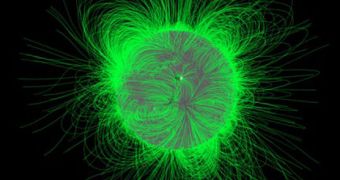In spite of being right under our noses, the Sun is still very little understood. While its physical and chemical traits have been established some time ago, there is still confusion about the underlying mechanisms that trigger the formation of events such as solar storms. Predicting them is of vital importance for our safety. As such, engineers at the American space agency NASA will launch a new telescope this winter, called the Solar Dynamics Observatory (SDO), Space reports.
The field of solar dynamics is very complex one, especially because it carries so much importance. Very large solar storms can penetrate the magnetosphere – our planet's protective shield – and wreak havoc among electrical grids. But, most importantly, they can “fry” satellites in orbit, bringing down communications networks and strategic capabilities for a large number of countries. Additionally, there is currently a permanent, six-member crew aboard the International Space Station (ISS), which will basically be doomed if they are in the way of such a massive solar storm.
It will be the SDO's job to ensure that the intricate workings of the Sun's magnetic fields are revealed. It is scheduled to spend more than 5 years studying the stars, hopefully sufficient time to figure out the mechanisms that govern the 11-year-long solar cycle. What causes the number of storms and sunspots to peak and drop at regular intervals is still anyone's guess, though admittedly a number of ideas to explain the phenomena exist. The observatory will also scrutinize carefully the effects that solar activities have on our planet, at times when solar storms are not a threat.
“The Sun is a magnetic variable star that fluctuates on times scales ranging from a fraction of a second to billions of years. SDO will show us how variable the Sun really is and reveal the underlying physics of solar variability,” explains Madhulika Guhathakurta, from the American space agency's headquarters, in Washington DC. The expert is also the lead program scientist for the Living With a Star program, which also includes the new telescope. The observatory will circle our planet in a figure-eight pattern, ensuring it always has a good vantage point on the star.
In order for it to be able to conduct its investigations, it will feature three scientific instruments, especially designed for the job. The first is the Helioseismic and Magnetic Imager (HMI), whose job is to generate maps of the plasma flows that generate the star's magnetic fields. It is also in charge of mapping the magnetic fields themselves. The second instrument is the Atmospheric Imaging Assembly (AIA), which will use multiple wavelength filters to image the solar atmosphere, from infrared to ultraviolet. The HMI/AIA collaboration will link internal changes to external effects.
The third and final instrument is the Extreme Ultraviolet Variability Experiment (EVE), whose job is to measure the Sun's radiation emission levels in the extreme ultraviolet wavelengths (EUV). While, in visible light, the star shows little changes in its brightness, variations become very visible in this portion of the electromagnetic spectrum. Researchers want to take a better look at the star using this knowledge.

 14 DAY TRIAL //
14 DAY TRIAL //